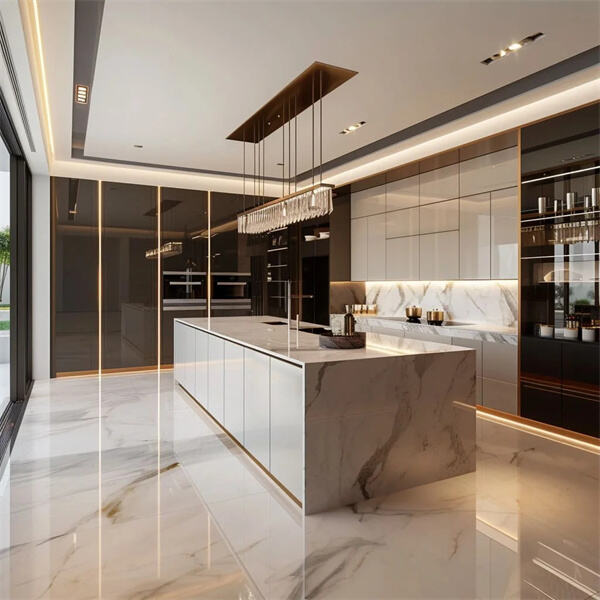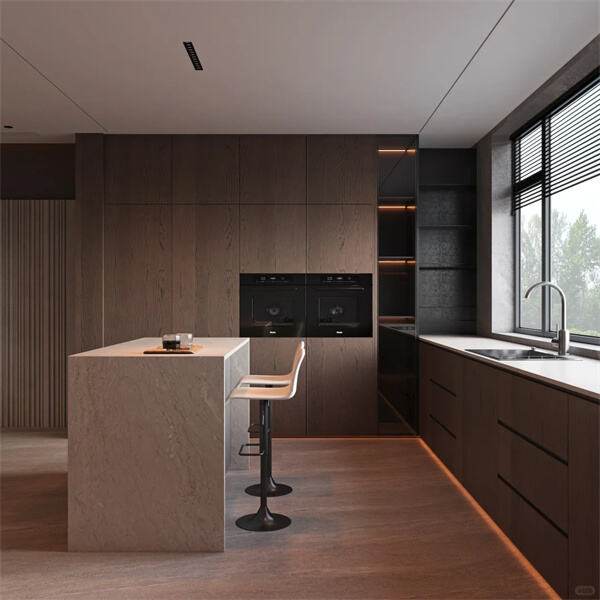ວິທີການນຳໃຊ້ພື້ນທີ່ເກັບຮັກສາໃຫ້ມີປະສິດທິພາບສູງສຸດດ້ວຍຕູ້ເຄື່ອງໃນຕຳຫຼວງ?
ຄັບເຄື່ອງປະຕູໄມ້ ເປັນພະຍານທີ່ບໍ່ໄດ້ຮັບການຍອມຮັບໃນການຈັດລຽງເຮືອນ, ແຕ່ເລື່ອງທີ່ເກີດຂຶ້ນເລື້ອຍໆແມ່ນສິ່ງທ້າທາຍຂອງພວກມັນຖືກສູນເສຍໄປກັບຊັ້ນວາງທີ່ບໍ່ເປັນລະບຽບແລະມຸມທີ່ເຂົ້າເຖິງຍາກ. ບໍ່ວ່າທ່ານຈະມີຕູ້ເຄື່ອງຄົວຂະໜາດນ້ອຍໃນອາພາດເມັນຕ໌ ຫຼື ພື້ນທີ່ໃຫຍ່ໃນຄົວຄອບຄົວ, ການເພີ່ມພື້ນທີ່ເກັບຮັກສາໃນຕູ້ເຄື່ອງຄົວສາມາດປ່ຽນຄວາມວຸ່ນວາຍໃຫ້ກາຍເປັນຄວາມເປັນລະບຽບ, ເຮັດໃຫ້ການປຸງອາຫານມີປະສິດທິພາບແລະມ່ວນຊື່ນຂຶ້ນ. ຈາກການຕິດຕັ້ງພາຍໃນທີ່ສະຫຼາດຈົນເຖິງການປັບປຸງຮູບແບບຢ່າງມີຍຸດທະສາດ, ຂໍໃຫ້ພວກເຮົາຄົ້ນຫາຍຸດທະສາດທີ່ພິສູດແລ້ວເພື່ອໃຊ້ປະໂຫຍດຕູ້ເຄື່ອງຄົວຂອງທ່ານໃຫ້ເຕັມທີ່.
ໃຊ້ພື້ນທີ່ຕັ້ງແຕ່ງ: ຄິດຂຶ້ນເທິງແລະລົງລ່າງ
ຂໍ້ຜິດພາດທີ່ໃຫຍ່ທີ່ສຸດໃນ ຕູ້ ການເກັບຮັກສາແມ່ນການບໍ່ໃຊ້ພື້ນທີ່ຕັ້ງແຕ່ງໃຫ້ເຕັມທີ່. ຄັບເຄື່ອງປະຕູໄມ້ ທັງໜ່ວຍຕິດຕັ້ງກັບຝາ ແລະ ຕູ້ຕັ້ງພື້ນ, ມີຄວາມສູງທີ່ມັກຖືກປະໄວ້ໂດຍສະເພາະເໜືອລະດັບຕາ ຫຼື ຕ່ຳກ່ວາລະດັບເຄື່ອງນັ່ງ
ສຳລັບຕູ້ເຄື່ອງຕິດຕັ້ງເທິງຝາ, ຕິດຕັ້ງຊັ້ນວາງຂອງທີ່ສາມາດປັບໄດ້ເພື່ອເກັບຮັກສາຂອງທີ່ມີຄວາມສູງຕ່າງກັນ. ອຸປະກອນຈັດເກັບທີ່ສາມາດຊ້ອນກັນໄດ້, ເຊັ່ນ ແຂ້ວວາງລວດ ຫຼື ກ່ອງພາດສະຕິກ, ສາມາດເພີ່ມພື້ນທີ່ເກັບຂອງໃນຊັ້ນດຽວເປັນສອງເທົ່າ. ຕົວຢ່າງ, ຕູ້ເຄື່ອງຕິດຝາທີ່ສູງ 36 ນິ້ວມີຊັ້ນວາງແບບຖາວອນອາດສາມາດເກັບຈານໄດ້ພຽງ 2–3 ຊັ້ນ, ແຕ່ຖ້າໃຊ້ຊັ້ນວາງປັບໄດ້ແລະແຂ້ວວາງຊ້ອນກັນໄດ້, ມັນສາມາດເກັບຈານໄດ້ເຖິງ 4–5 ຊັ້ນ ແລະ ພ້ອມທັງແຍກຖ້ວຍ, ຊາມ, ແລະ ຈານອອກຈາກກັນຢ່າງມີປະສິດທິພາບ. ຢ່າລືມພື້ນທີ່ເທິງຕູ້ເຄື່ອງເຊັ່ນກັນ—ໃຊ້ກະຕ່າ ຫຼື ກ່ອງຕົກແຕ່ງເກັບຂອງໃຊ້ລະດູການເຊັ່ນ ເຄື່ອງປຸງອາຫານໃນວັນພັກ ຫຼື ໄມ້ຂະຫຍາຍຕຽງ, ເພື່ອຮັກສາຂອງເຫຼົ່ານີ້ໃຫ້ຢູ່ໃນທີ່ສາມາດເອົາໄດ້ແຕ່ບໍ່ເຫັນໃນຊີວິດປະຈຳວັນ.
ຕູ້ເຄື່ອງໃຕ້ຖານມັກຈະເສຍປະໂຫຍດເນື່ອງຈາກຊັ້ນເກັບຂອງທີ່ເລິກແລະມືດ, ສາມາດປັບປຸງໄດ້ດ້ວຍການຕິດຕັ້ງແບ່ງຊ້ອນຕັ້ງ. ສ່ວນເ erg ການຂະຫຍາຍນີ້ (ເຮັດຈາກໄມ້ ຫຼື ໂລຫະ) ຈະປ່ຽນຕູ້ທີ່ກ້ວາງໃຫ້ກາຍເປັນຊ່ອງທາງສໍາລັບເກັບແຜ່ນເບື້ອ, ແຜ່ນຕັດ, ແລະ ຖາດຕ່າງໆ. ແທນທີ່ຈະວາງເຄື່ອງເຫຼົ່ານີ້ແນວນອນ (ເຊິ່ງຍາກຕໍ່ການເອົາອອກ) ການຕິດຕັ້ງແບ່ງຊ້ອນຕັ້ງຈະຊ່ວຍໃຫ້ສາມາດສາກເຂົ້າ-ອອກຕາມແນວຕັ້ງໄດ້, ປະຢັດພື້ນທີ່ ແລະ ລົດບັນຫາຄວາມໜ້າສົນໃຈ. ສໍາລັບຄວາມສູງເພີ່ມເຕີມ, ຕິດຕັ້ງລິ້ນຊັກທີ່ເອີ້ນວ່າ “ຕູ້ລິ້ນເທົ້າ” ຢູ່ຂ້າງລຸ່ມຕູ້ເຄື່ອງໃຕ້ຖານ - ສະເໝາະສໍາລັບເກັບແຜ່ນເບື້ອ, ຜ້າ, ຫຼື ເຖິງແມ້ກະທັ້ງເກົ້າອີ້ຕັ່ງນ້ອຍໆ, ເພື່ອໃຊ້ປະໂຫຍດຈາກພື້ນທີ່ທີ່ມັກຖືກເມີນເນື່ອງຈາກພື້ນທີ່ລະຫວ່າງຕູ້ກັບພື້ນເຮືອນ.
ປັບປຸງຄວາມເລິກຂອງຕູ້ເຄື່ອງ: ສາມາດເຂົ້າເຖິງທຸກນິ້ວ
ຕູ້ເຄື່ອງໃນຕຳໜິດທີ່ເລິກເປັນປົກກະຕິປະມານ 24 ນິ້ວ, ມັກຈະມີບັນຫາເຊື່ອງເຄື່ອງຂອງໄວ້ຂ້າງຫຼັງເຊິ່ງເຮັດໃຫ້ຖ້ວຍຖາດບໍ່ໄດ້ໃຊ້ງານ, ວັດຖຸດິບໝົດອາຍຸ, ຫຼື ເຄື່ອງມືຕ່າງໆຖືກລືມ. ຫຼັກການສໍາຄັນໃນການນໍາໃຊ້ປະໂຫຍດຈາກຄວາມເລິກແມ່ນການເຮັດໃຫ້ທຸກນິ້ວສາມາດເຂົ້າເຖິງໄດ້, ລວມເຖິງແມ້ກະທັ້ງມຸມທີ່ຢູ່ໃນສຸດ.
ຊັ້ນແລະລິ້ນຊັກທີ່ສາມາດດຶງອອກໄດ້ເປັນສິ່ງທີ່ປ່ຽນແປງກັບຕູ້ລຸ່ມທີ່ເກັບຂອງໄດ້ຫຼາຍ. ລະບົບການເລື່ອນນີ້ສາມາດຍືດເຕັມທີ່, ນຳເອົາຂອງທີ່ຢູ່ດ້ານຫຼັງອອກມາທາງໜ້າໄດ້ພຽງແຕ່ດຶງງ່າຍໆ. ຕົວຢ່າງ, ລິ້ນຊັກທີ່ສາມາດດຶງອອກໄດ້ໃນຕູ້ລຸ່ມສາມາດເກັບໝໍ້ແລະແຊ່ວໄດ້, ໃນຂະນະທີ່ຂອງທີ່ຢູ່ເບື້ອງໃນສຸດກໍສາມາດເຂົ້າເຖິງໄດ້ຢ່າງງ່າຍດາຍໂດຍບໍ່ຕ້ອງຍ່າງຄຸເຂົ່າຫຼືຄົ້ນຫາຍາກ. ສຳລັບຕົວຢ່າງທີ່ມີກົນໄກປິດຊ້າເພື່ອປ້ອງກັນການປິດແຮງແລະການສຶກ.
ໃນຕູ້ມຸມທີ່ມັກຈະກາຍເປັນ 'ຄັນເມີ' ສຳລັບການເກັບຮັກສາ, ລະບົບລິ້ນຊັກມຸມຫຼືລິ້ນຊັກທີ່ສາມາດດຶງອອກໄດ້ເອີ້ນວ່າ 'ມຸມເວທະມົນ' ຈະເຮັດໃຫ້ມີປະສິດທິພາບ. ລິ້ນຊັກສອງຊັ້ນສາມາດເກັບເຄື່ອງຄັກ, ນ້ຳຈິ້ມ ຫຼື ເຄື່ອງໃຊ້ໄຟຟ້າຂະໜາດນ້ອຍໄດ້, ສະໝໍ່າສະເໝີເພື່ອນຳເອົາຂອງອອກມາໃຊ້ງ່າຍ. ສຳລັບຂອງໃຫຍ່ກວ່າເຊັ່ນ: ແຊ່ວຄຸກ, ລິ້ນຊັກມຸມເວທະມົນ (ຊັ້ນທີ່ຍືດອອກມາຕາມແນວທแຍງ) ຈະຊ່ວຍໃຫ້ບໍ່ຕ້ອງຍື່ນມືເຂົ້າໄປໃນມຸມທີ່ເລິກທີ່ສຸດ, ທຳໃຫ້ມຸມທີ່ໄກທີ່ສຸດກໍໃຊ້ງ່າຍ.
ສໍາລັບຕູ້ທີ່ແຄບ (ມັກຫຼືເກີດຂຶ້ນໃນຄົວແຄບ), ຕູ້ເລິກບາງ 6-12 ນິ້ວເໝາະສົມທີ່ສຸດ. ຕູ້ເຫຼົ່ານີ້ສາມາດຕິດຕັ້ງລະຫວ່າງເຄື່ອງໃຊ້ໄຟຟ້າ ຫຼື ໃນຊ່ອງທີ່ແຄບ, ເພື່ອເກັບເຄື່ອງຄັ້ນ, ນ້ໍາມັນທາດ, ຫຼື ອຸປະກອນເຮັດຄວາມສະອາດ. ບາງຕົ້ນແບບມາພ້ອມກັບແບ່ງຊ້ອນພາຍໃນ, ທີ່ຊ່ວຍຮັກສາຂວດໃຫ້ຢືນຕົ້ນຕະຫຼອດເວລາ ແລະ ສາມາດເບິ່ງເຫັນໄດ້ຊັດເຈນ.
ຊິ້ນສ່ວນປັບແຕ່ງ ແລະ ອຸປະກອນຈັດເກັບ: ປັບແຕ່ງຕາມຄວາມຕ້ອງການຂອງທ່ານ
ຕູ້ຄົວຈະກາຍເປັນພື້ນທີ່ໃຊ້ງານໄດ້ຫຼາຍຂຶ້ນດ້ວຍຊິ້ນສ່ວນ ແລະ ອຸປະກອນຈັດເກັບທີ່ຖືກອອກແບບມາສໍາລັບວັດຖຸປະເພດຕ່າງໆ. ອຸປະກອນເຫຼົ່ານີ້ຈະປ່ຽນຊັ້ນວາງທົ່ວໄປໃຫ້ກາຍເປັນພື້ນທີ່ເກັບຮັກສາພິເສດ, ຮັບປະກັນວ່າເຄື່ອງມື, ເຄື່ອງໃຊ້ ຫຼື ອຸປະກອນທຸກຊິ້ນມີສະຖານທີ່ເກັບຮັກສາທີ່ກໍານົດໄວ້.
- ຕູ້ລິ້ນ (Drawer) ອຸປະກອນຈັດເກັບ: ຕູ້ລິ້ນພາກລຸ່ມ (ຫຼື ຕູ້ລິ້ນຕິດຝາທີ່ຕື້ນ) ສາມາດໃຊ້ປະໂຫຍດຈາກຊິ້ນສ່ວນແບ່ງພາຍໃນທີ່ມີຊ່ອງແບ່ງປັບໄດ້. ຊ່ອງແບ່ງທີ່ເຮັດຈາກໄມ້ bamboo ຫຼື ພາດສະຕິກ ສາມາດແຍກເຄື່ອງມື, ຊ້ອນຕวง, ຫຼື ເຄື່ອງມືນ້ອຍໆເຊັ່ນ ເຄື່ອງເປີດກະປ໋ອງໄດ້. ສໍາລັບຕູ້ລິ້ນທີ່ເລິກກວ່າ, ອຸປະກອນຈັດເກັບແບບຊັ້ນຍ່ອຍຊ່ວຍໃຫ້ສາມາດເກັບຂອງຊ້ອນກັນໄດ້ – ຕົວຢ່າງ, ວາງມີດ ແລະ ກັນທຽມໄວ້ຂ້າງເທິງ ແລະ ຊ້ອນໃຫຍ່ໃນຊັ້ນລຸ່ມ.

- ຊັ້ນວາງເຄື່ອງແປ້ງ: ແທນທີ່ຈະເອື້ອມເຄື່ອງແປ້ງເຂົ້າໄປໃນຊັ້ນຕູ້ທີ່ບໍ່ເປັນລະບຽບ, ຕິດຕັ້ງຊັ້ນວາງເຄື່ອງແປ້ງແບບຕັ້ງ. ສາມາດຕິດຕັ້ງໄດ້ພາຍໃນປະຕູຕູ້ (ໂດຍໃຊ້ແຜ່ນເຫຼັກດູດຫຼືຊັ້ນວາງທີ່ຕິດກັບປະຕູ) ຫຼືເປັນຊິ້ນສ່ວນທີ່ສາມາດດຶງອອກໄດ້ໃນຕູ້ລຸ່ມ. ຂວດທີ່ມີປ້າຍຄຳອະທິບາຍຈະຊ່ວຍໃຫ້ທ່ານເຫັນວ່າມີຫຍັງແດ່, ລົດຜົນການຊື້ຊ້ຳແລະຂອງເສຍ.
- ຕົກແຕ່ງໝໍ້: ເຄື່ອງໃຊ້ໃນເຮືອນທີ່ໜັກກວ່າກິນພື້ນທີ່ແລະຍາກທີ່ຈະເກັບໃຫ້ເປັນລະບຽບ. ຊັ້ນວາງໝໍ້ທີ່ຕິດຢູ່ດ້ານລຸ່ມຕູ້ຕິດກັບຝາຈະຊ່ວຍປົດວິກົດພື້ນທີ່ໃນຕູ້ລຸ່ມ, ແຕ່ຖ້າບໍ່ສາມາດເຮັດໄດ້, ໃຊ້ໂຕຈັດໝໍ້ແບບຕັ້ງພາຍໃນຕູ້ລຸ່ມ. ເຄື່ອງມືນີ້ໃຊ້ຂອບຫຼືຊ່ອງເພື່ອຖືໝໍ້ແລະແປ້ນໃຫ້ຢືນຕົ້ນ, ແລະຝາຖືກເກັບໄວ້ໃນຊັ້ນວາງໃກ້ຄຽງ.
- ຕົກແຕ່ງແຜ່ນ: ໃນຕູ້ຕິດກັບຝາ, ຕົກແຕ່ງແຜ່ນ (ແຜ່ນໄມ້ຫຼືໂລຫະທີ່ສາມາດປັບໄດ້) ຈະຊ່ວຍຮັກສາແຜ່ນເບັກີ້, ແຜ່ນເຮັດເຄັກມູຟິນ, ແລະແຜ່ນເຢັນໃຫ້ຢືນຕົ້ນແລະແຍກກັນ. ສິ່ງນີ້ຈະຊ່ວຍບໍ່ໃຫ້ມັນເລື່ອນໄປມາແລະກິນພື້ນທີ່ເກີນ.
ຊິ້ນສ່ວນເພີ້ມເຕີມເຫຼົ່ານີ້ມັກຈະຖືກລາຄາແລະຕິດຕັ້ງງ່າຍ, ດັ່ງນັ້ນຈຶ່ງເປັນທາງເລືອກທີ່ດີເມື່ອຕ້ອງການເພີ່ມພື້ນທີ່ເກັບມ້ຽນໃນຕູ້ເຄື່ອງໃນຕູ້ຄົວທີ່ມີຢູ່.
ຈັດການແລະໃຫ້ຄວາມສຳຄັນ: ເກັບຮັກສາພຽງແຕ່ສິ່ງທີ່ທ່ານໃຊ້ງານ
ຕູ້ເຄື່ອງໃນຕູ້ຄົວທີ່ຖືກຈັດແບບດີທີ່ສຸດກໍ່ຈະຮູ້ສຶກອັບເວົ້າຖ້າຫາກວ່າເຕັມໄປດ້ວຍສິ່ງຂອງທີ່ບໍ່ຈຳເປັນ. ກ່ອນທີ່ຈະລົງທຶນໃນອຸປະກອນຈັດເກັບ, ໃຊ້ເວລາໃນການຈັດລົບລ້າງສິ່ງທີ່ບໍ່ຈຳເປັນ - ຂັ້ນຕອນດຽວນີ້ສາມາດຊ່ວຍໃຫ້ທ່ານມີພື້ນທີ່ເພີ່ມຂື້ນ 20-30% ໃນຕູ້ເຄື່ອງ.
ເລີ່ມຕົ້ນດ້ວຍການຖອກເອົາເນື້ອໃນຂອງຕູ້ແຕ່ລະຕູ້ອອກແລ້ວຈັດປະເພດເປັນໝວດໆ: ເກັບຮັກສາ, ບໍລິຈາກ, ຮີໄຊເຄີນ ຫຼື ທິ້ງ. ຈົ່ງດຸ່ນຮ້າຍ: ອາຫານໝົດອາຍຸ, ຈານແຕກ, ຫຼື ອຸປະກອນທີ່ບໍ່ໄດ້ໃຊ້ງານໃນຮອບປີ (ຕົວຢ່າງ: ເຄື່ອງຕັດແອວໂຄເດກ ຫຼື ເຄື່ອງທຳເຂົ້າປັງ) ສາມາດຖິ້ມໄດ້. ສຳລັບຂອງໃຊ້ທີ່ອີງຕາມລະດູການເຊັ່ນ: ແປ້ງຕັດເຄືອກເຂົ້າປັງໃນວັນພິເສດ ຫຼື ຈານໃຫຍ່ສຳລັບເສີບ, ສາມາດເກັບໄວ້ໃນບ່ອນທີ່ເຂົ້າເຖິງຍາກໜ້ອຍ (ຕົວຢ່າງ: ຊັ້ນເທິງສຸດຂອງຕູ້ຕິດຝາ) ເພື່ອປົດວ່າງພື້ນທີ່ດີໃຫ້ກັບຂອງໃຊ້ຈຳເປັນປະຈຳວັນ.
ຫຼັງຈາກທີ່ຈັດລົບສິ່ງຂອງແລ້ວ, ກຳນົດແຜນການໃຫ້ກັບຕູ້ເຄື່ອງໃນເຮືອນຄົວຂອງທ່ານຕາມການນຳໃຊ້. ສິ່ງຂອງທີ່ໃຊ້ປະຈຳວັນ (ຖ້ວຍ, ແກ້ວນ້ຳ, ນ້ຳມັນປຸງອາຫານ) ຄວນເກັບໄວ້ໃນບ່ອນທີ່ເຂົ້າເຖິງໄດ້ງ່າຍ - ສູງປະມານຕາ ແລະ ຕູ້ດ້ານເທິງຂອງໜ່ວຍດ້ານລຸ່ມ. ສິ່ງຂອງທີ່ໃຊ້ບໍ່ພ້ອມ (ຕົກແບ້, ອຸປະກອນພິເສດ) ສາມາດເກັບໄວ້ໃນຕູ້ດ້ານລຸ່ມ ຫຼື ເທິງຊັ້ນສູງ. ລະບົບນີ້ຈະຊ່ວຍໃຫ້ທ່ານບໍ່ເສຍພື້ນທີ່ມີຄ່າກັບສິ່ງຂອງທີ່ບໍ່ໄດ້ໃຊ້ງານ.
ອຸປະກອນເພີ່ມເຕີມສະເພາະ: ການຂະຫຍາຍການນຳໃຊ້ຕູ້ເຄື່ອງ
ສຳລັບເຮືອນຄົວທີ່ມີຮູບແບບເປັນເອກະລັກ ຫຼື ຄວາມຕ້ອງການເກັບຮັກສາສະເພາະ, ອຸປະກອນເພີ່ມເຕີມສະເພາະສາມາດເພີ່ມພື້ນທີ່ເພີ່ມເຕີມໃຫ້ກັບຕູ້ເຄື່ອງໃນເຮືອນຄົວທີ່ມີຢູ່. ການປັບປຸງເຫຼົ່ານີ້ສາມາດເລີ່ມຕົ້ນຈາກໂຄງການງ່າຍໆທີ່ເຮັດເອງ ຫຼື ການຕິດຕັ້ງໂດຍຊ່າງ ຂຶ້ນຢູ່ກັບລະດັບທັກສະຂອງທ່ານ.
- ການເກັບຮັກສາປະຕູຕູ້: ດ້ານໃນຂອງປະຕູຕູ້ເປັນບ່ອນທີ່ດີເລີດສໍາລັບວັດຖຸຂະຫນາດນ້ອຍ. ຕິດຕັ້ງແຜ່ນເຫຼັກທີ່ມີແມ່ເຫຼັກເພື່ອເກັບມີດ (ປະຢັດພື້ນທີ່ລິ້ນຊັກ), ຫຼືຕິດຕັ້ງຊັ້ນວາງຝາປິດ, ຖົງມືເຂົ້າເຕົາ, ຫຼືແມ້ກະທັ້ງອຸປະກອນເຮັດຄວາມສະອາດໃນຕູ້ພາຍໃຕ້ຊັກລ້າງ. ຖົງຢາງທີ່ຈະແຈ້ງທີ່ຕິດຢູ່ປະຕູສາມາດເກັບບັດສູດອາຫານ ຫຼືບັນຊີຂອງທີ່ຕ້ອງຊື້ໄດ້, ເຮັດໃຫ້ພວກມັນຢູ່ໃນມືແຕ່ບໍ່ເຢັ່ງ.
- ຊັ້ນວາງຕູ້ເກັບເຄື່ອງທີ່ສາມາດດຶງອອກໄດ້: ຖ້າທ່ານມີພື້ນທີ່ແຄບລະຫວ່າງຕູ້ ຫຼືຕິດກັບຕູ້ເຢັນ, ຕູ້ເກັບເຄື່ອງແບບດຶງອອກເອງສາມາດເພີ່ມພື້ນທີ່ເກັບເຄື່ອງໄດ້ຫຼາຍແມັດ. ຕູ້ເຫຼົ່ານີ້ສາມາດຕິດຕັ້ງໃນພື້ນທີ່ທີ່ແຄບພຽງແຕ່ 6 ນິ້ວ, ມີຊັ້ນວາງສໍາລັບເກັບຂວດ, ອາຫານຂົບຄົບ, ຫຼືສ່ວນປະກອບແຫ້ງ.
- ໂຮກເທິງປະຕູຕູ້: ສໍາລັບວັດຖຸທີ່ໃຊ້ທຸກມື້ແຕ່ຫາກົງຈັດເກັບຍາກ (ຕົວຢ່າງ: ຖ້ວຍ, ຜ້າເຊັດຈານ), ຕິດຕັ້ງໂຮກຢູ່ດ້ານລຸ່ມຂອງຕູ້ຝາຜະນັງ. ນີ້ຈະເຮັດໃຫ້ພວກມັນສະດວກໃນການເຂົ້າເຖິງໂດຍບໍ່ຕ້ອງໃຊ້ພື້ນທີ່ຊັ້ນວາງ, ແລະເພີ່ມສໍາເລັດຮູບແບບເຄື່ອນຍ້າຍໃນຕູ້ເຮືອນທີ່ເປີດ.
FAQ: ການເພີ່ມກໍານົດພື້ນທີ່ເກັບຮັກສາດ້ວຍຕູ້ເຮືອນຄົວ
ຂ້ອຍຈະເພີ່ມກໍານົດພື້ນທີ່ເກັບຮັກສາໃນຕູ້ເຮືອນຄົວຂະຫນາດນ້ອຍໄດ້ແນວໃດ?
ໃຫ້ໃຊ້ບ່ອນເກັບມ້ຽນແບບຕັ້ງແລະໃນປະຕູ: ໃຊ້ກ່ອງທີ່ສາມາດຊື້ກັນໄດ້, ແຜ່ນວາງເຄື່ອງປຸງລົດຊາດທີ່ຕິດກັບປະຕູ, ແລະ ແຜ່ນຊື້ລົງມາຈາກເທິງ. ລະວັງຢ່າວາງຂອງເປັນຊັ້ນໜາເກີນໄປ—ເລືອກໃຊ້ອຸປະກອນຈັດເກັບແບບຕື້ນໆເພື່ອໃຫ້ເຫັນຂອງທີ່ເກັບໄດ້ຊັດເຈນ. ພິຈາລະນາການຖອດປະຕູຕູ້ອອກແລ້ວໃຊ້ຊັ້ນເປີດ, ສາມາດເຮັດໃຫ້ພື້ນທີ່ນ້ອຍໆຮູ້ສຶກກ້ວາງຂຶ້ນໃນຂະນະທີ່ຍັງສາມາດເຂົ້າເຖິງຂອງທີ່ຈໍາເປັນໄດ້ງ່າຍ.
ມີວິທີໃດດີທີ່ສຸດໃນການຈັດເຄື່ອງໝໍ້ແລະແຊ່ວໃນຕູ້ລຸ່ມ?
ໃຊ້ແຜ່ນກັ້ນແບບຕັ້ງສໍາລັບຝາປິດ ແລະ ແຜ່ນຊື້ອອກສໍາລັບໝໍ້. ຕິດແຊ່ວທີ່ໃຊ້ເລື້ອຍໆເຂົ້າກັບແຜ່ນແຂວນເທິງເພດານ ຫຼື ກ້ຽມທີ່ຕິດຢູ່ດ້ານລຸ່ມຕູ້ເພື່ອປະຢັດພື້ນທີ່ໃນຕູ້ລຸ່ມ. ວາງໝໍ້ຕາມຂະໜາດໂດຍວາງອັນນ້ອຍໃສ່ໃນອັນໃຫຍ່, ແລະ ໃຊ້ຕູ້ຈັດແຊ່ວ (ທີ່ມີຊ່ອງ) ເພື່ອປ້ອງກັນບໍ່ໃຫ້ເກີດຮອຍຂີດຂ້າ.
ຂ້ອຍຈະເກັບເຄື່ອງປຸງລົດຊາດແນວໃດເພື່ອໃຊ້ພື້ນທີ່ໃນຕູ້ໃຫ້ມີປະສິດທິພາບສູງສຸດ?
ຕິດແຜ່ນດູດເຫຼັກພາຍໃນປະຕູຕູ້ສໍາລັບກ່ອງເຄື່ອງປຸງລົດຊາດທີ່ເປັນໂລຫະ, ຫຼື ໃຊ້ຕູ້ວາງເຄື່ອງປຸງລົດຊາດແບບຊື້ອອກໃນຕູ້ທີ່ແຄບ. ຈັດກຸ່ມເຄື່ອງປຸງລົດຊາດຕາມປະເພດ (ຕົວຢ່າງ: ເຄື່ອງຂອງຫວານ, ເຄື່ອງຄາວ) ແລະ ຕິດສະຫຼາກໃຫ້ຊັດເຈັນ. ລະວັງບໍ່ໃຫ້ເກັບເຄື່ອງປຸງລົດຊາດເທິງເຕົາ—ຄວາມຮ້ອນ ແລະ ກ້ານລົມສາມາດເຮັດໃຫ້ລົດຊາດເສື່ອມຄຸນນະພາບ.
ຂ້ອຍສາມາດເພີ່ມພື້ນທີ່ເກັບຮັກສາໃນຕູ້ເຄື່ອງເຮືອນຄົວທີ່ມີຢູ່ແລ້ວໄດ້ໂດຍບໍ່ຕ້ອງປ່ຽນໃໝ່ບໍ?
ໄດ້ຢ່າງແນ່ນອນ. ຕິດຕັ້ງຊັ້ນວາງຂອງປັບໄດ້, ຕູ້ລິ້ນຊັກແລະໂຄງການຈັດເຂົ້າເບິ່ງ. ສາມາດໃຊ້ຕຸ້ມແລະແຖບດູດຕິດກັບປະຕູ ຫຼື ແຂວນເທິງປະຕູເພື່ອເພີ່ມພື້ນທີ່. ສໍາລັບວິທີແກ້ໄຂທີ່ຖາວອນກວ່າ, ສາມາດເອີ້ນຊ່າງມືອາຊີບໃຫ້ຕິດຕັ້ງລິ້ນເທິງແລະເພີ່ມແບ່ງພາກສ່ວນໃນຊັ້ນວາງທີ່ມີຢູ່ແລ້ວ.
ຄວາມລັບໃນການຮັກສາຕູ້ເຄື່ອງເຮືອນຄົວໃຫ້ເປັນລະບຽບໃນໄລຍະຍາວແມ່ນຫຍັງ?
ກໍານົດສະຖານທີ່ເກັບຮັກສາສໍາລັບທຸກໆສິ່ງຂອງແລະຕິດປ້າຍຊື່ໃສ່ຊັ້ນວາງຫຼືກ່ອງ. ທຸກໆເດືອນຄວນຈັດລົບລ້າງຂອງທີ່ບໍ່ໄດ້ໃຊ້. ສອນສະມາຊິກໃນຄອບຄົວໃຫ້ວາງຂອງຄືນທີ່ສະຖານທີ່ກໍານົດໄວ້. ພິຈາລະນາການເພີ່ມພື້ນທີ່ເກັບຊົ່ວຄາວ (ກ່ອງນ້ອຍໆ) ສໍາລັບຂອງທີ່ຕ້ອງຈັດຕໍ່ໄປເພື່ອບໍ່ໃຫ້ເກີດຄວາມວຸ່ນວາຍທຸກມື້.
ສາລະບານ
- ວິທີການນຳໃຊ້ພື້ນທີ່ເກັບຮັກສາໃຫ້ມີປະສິດທິພາບສູງສຸດດ້ວຍຕູ້ເຄື່ອງໃນຕຳຫຼວງ?
-
FAQ: ການເພີ່ມກໍານົດພື້ນທີ່ເກັບຮັກສາດ້ວຍຕູ້ເຮືອນຄົວ
- ຂ້ອຍຈະເພີ່ມກໍານົດພື້ນທີ່ເກັບຮັກສາໃນຕູ້ເຮືອນຄົວຂະຫນາດນ້ອຍໄດ້ແນວໃດ?
- ມີວິທີໃດດີທີ່ສຸດໃນການຈັດເຄື່ອງໝໍ້ແລະແຊ່ວໃນຕູ້ລຸ່ມ?
- ຂ້ອຍຈະເກັບເຄື່ອງປຸງລົດຊາດແນວໃດເພື່ອໃຊ້ພື້ນທີ່ໃນຕູ້ໃຫ້ມີປະສິດທິພາບສູງສຸດ?
- ຂ້ອຍສາມາດເພີ່ມພື້ນທີ່ເກັບຮັກສາໃນຕູ້ເຄື່ອງເຮືອນຄົວທີ່ມີຢູ່ແລ້ວໄດ້ໂດຍບໍ່ຕ້ອງປ່ຽນໃໝ່ບໍ?
- ຄວາມລັບໃນການຮັກສາຕູ້ເຄື່ອງເຮືອນຄົວໃຫ້ເປັນລະບຽບໃນໄລຍະຍາວແມ່ນຫຍັງ?

